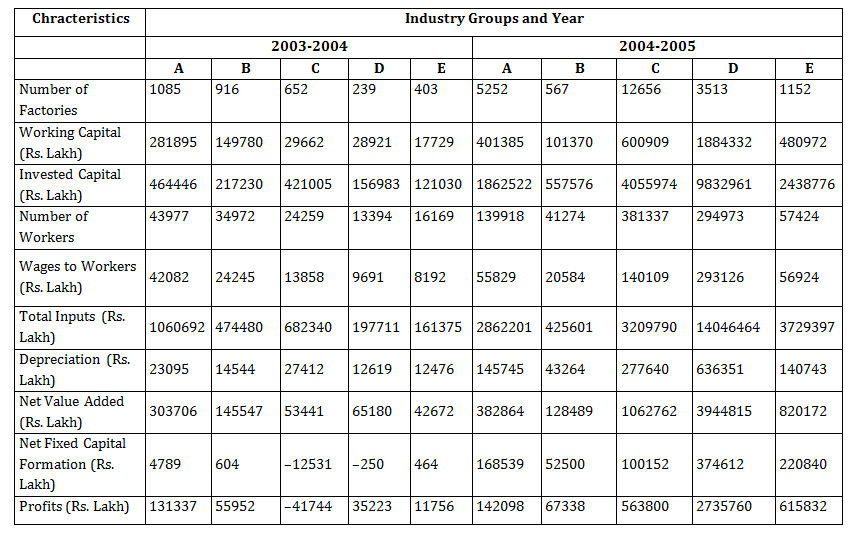Table : Estimate of some Important Characteristics of Select Industries
Question 1. Which of the following statement is not false?
A. Between 2003-2004 and 2004-2005, the average no. of workers per factory increased for industries B and C, but decreased for A.
B. The percentage change in no. of workers between 2003-2004 and 2004-2005 is higher in industry A than industry E.
C. The average no. of workers perfactory between industries D and E jointly increased by more than corresponding figure for B.
D. The average no. of workers perfactory C decreased between 2003-2004 and 2004-2005 by 6.
Question 2. Which of the following statement is true?
A. The increase in invested capital per worker for industries B and D over the period is jointly higher than the same for E.
B. The invested capital per worker has remained second highest for industry D both between 2003-2004 and 2004-2005.
C. The working capital per worker has been highest for industry B during 2003-2004 but not the lowest during 2004-2005.
D. The working capital to worker ratio has declined by more than 50 percent in case of industry A over the period, but by less than 50 percent for industry B.
Question 3. Which of the following statement is false?
A. Working capital to invested capital ratio has been second highest for industry E during 2004-2005.
B. Industry C is the only industry for which the net value added to total input ratio has increased between 2003-2004 and 2004-2005.
C. If average wage rate is defined by total wage bill divided by number of workers, then for a
total number of three industries, average wage rate declined between 2003-2004 and 2004-2005.
D. Net value added to total input ratio has been highest for industry B during 2004-2005.
Question 4. If gross fixed capital formation is defined as net fixed capital formation plus depreciation, then which of the following statement is true?
A. Gross fixed capital formation has been third highest for industry C during 2004-2005.
B. Gross fixed capital formation is the lowest for industry E during 2003-2004
C. The increase in gross fixed capital formation between 2003-2004 and 2004-2005 for industry D is higher than the sum total of the same for industries C and E.
D. The increase in average depreciations per factory between 2003-2004 and 2004-2005 has been second highest for industry D.
Question 5. Which of the following statement is false?
A. Average profit perfactory is second highest for industry A during 2003-2004 but lowest during 2004-2005.
B. Average profit earned per unit of input cost incurred is second highest for industry A and C both between 2003-2004 and 2004-2005 respectively.
C. The average profit to the number of workers ratio is second highest for industry D both between 2003-2004 ad 2004-2005.
D. The increase in average expenditure on input perfactory between 2003-2004 and 2004-2005 has been highest for industry D.
Answers and Explanations
Answer 1. (D)
The average number of works per factory for factory C decreased between 2003-04 by 7 so automatically by 6. All other statements are completely false.
* Note: The statement (D) must have been the average number of workers per factory for factory C decreased between 2003-04 and 2004-05 by 7.
Answer 2. (B)
Hence, D is ranked second both between 2003-04 and 2004-05.
Answer 3. (A)
Hence, E has the second highest ratio.
Answer 4. (C)
Increase in gross fixed capital formation between 2003 – 04 and 2004 – 05 for D = 1010963 – 12369 = 9,98,594. Corresponding increase for C and E = 739375 – 27821 = 7,11,554.
Answer 5. (A)
Hence, A has the second highest and the lowest average profit per factory for 2003-04 and 2004-05 respectively.











